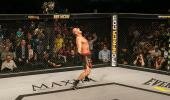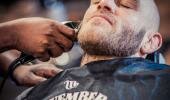Words: Liane Wadman | Photos: Various Photographers
I was first exposed to Wushu training in 2004 and I can easily say that it’s changed my life, and - despite many injuries, and one in particular that almost ended my career - I haven’t looked back.
Photo credit: Andre van Rooyen
What is Wushu?
Wushu, commonly known as Kung Fu, is a term used to identify Chinese martial arts, which is a large part of China’s traditional culture. Wushu is an art involving the use of both physical vigour and mental concentration not only as a form of self-defence but also as an artistic form. It has a tremendous history and is extremely popular in China, but due to its uniqueness and charisma, and thanks to the efforts of organisations such as the International Wushu Federation (IWUF), Wushu is gaining the attention of more and more people all over the world.
In 2009, I was selected to compete in the tenth World Wushu Championships, held in Toronto, Canada in October. This was an official World Championship, as recognised by the International Olympic Committee and the General Association of International Sports Federations, and I was awarded my National Protea colours. I was also the only female selected for the team, to compete in the Sanshou (free fighting) division.
My training for this competition increased to insane levels. I was training three times a day, six days a week. As a result, I was not allowing my body the necessary rest and recovery and I started developing quite a few niggling injuries. One such injury was to my shins. I was out running one day and about 3 km into the run, I had to stop at a traffic intersection. My legs had been paining during the run, but I was so focused that I just kept running. When the traffic stopped and I tried to run, I simply couldn’t. My legs wouldn’t move and I collapsed to the ground. I stayed on the ground for quite some time, and then eventually willed myself to get up and find the nearest store to phone my sister to come fetch me. Nevertheless, I let the physiotherapist treat my legs, carried on training through the pain, and went to the World Championships.
Jump from 2009 to 2011, and I still had this injury (plus a busted ankle and a grade 2 tear to the ligaments in 2010). Despite my injury, I competed at the SA Wushu National Championships in August 2011 in Taolu (forms). Although it was a successful tournament for me and I won two gold medals for the two categories I competed in, I was going to try some alternative medicine to treat my legs. Eventually my coach instructed me to see a physician at the Sports Science Institute of SA. I went to see Prof. Wayne Derman, who sent me for a triple phase bone scan. The results showed extensive damage to both tibias, with multiple borderline stress fractures. The actual diagnosis was bilateral shin splints, with subtle muscle strains and compensation injuries. The treatment was physiotherapy, biokinetics, and rest. I’m talking serious rest – I was told to stay off my legs as much as possible.
Following the initial scan were dozens of blood tests to establish if the cause of these injuries was just from excessive training or if there was anything else wrong with me. Everything came back clear. A further bone density scan also came back clear and showed that my bones were fine, so yet another ‘theory’ crushed.
The pain continued as the months passed by. I sat watching my Wushu brothers training, learning new forms, becoming stronger, and perfecting moves, while I couldn’t do anything. I was not in a good space. I was heading into a downward spiral of depression.
The Prof. was somewhat stumped and concerned, so he recommended I see the psychologist. I was told to prepare myself for the possibility of never being able to train and compete again.
I remember how the Prof spoke to me, asking me to think about who I am beyond my sport, asking me if my identity is based on my sport - what I do, what I had achieved. He asked me who I would be if I no longer have my sport in my life. I remember not knowing what the answer would be. Wushu is more than my sport, it’s who I am. The thought of losing it was indescribable. Depression set in.
I went back to my Wushu school later that week. At this point, it was almost torturous to go and watch, but I didn’t want to miss more than I already was. My thought was as long as my coach was still teaching, I could still learn.
That evening, my coach wasn’t there and only my senior ‘brother’ was there to talk to. I told him about the psychologist that I had to see and he actually became angry. Angry because I was allowing the injury to get the better of me. Angry for seeing ‘the tiger’ lying down and accepting defeat. I cried because I didn’t know what to do, how to handle it, how to accept it. I cried because I thought I was alone.
Photo credit: Andre van Rooyen
I wasn’t alone. I had my coach, my senior ‘brother’, my other Wushu brothers, my family, friends, and my physiotherapist (a friend and fellow athlete who was also going through injuries) for morale support, and my biokineticist, who was working hard to strengthen whatever she could to ease the pain in my legs.
I changed my thinking. I became more positive. I knew I would train again, and never stopped thinking about the day I would be training with my brothers again.
Six months after my initial appointment with the Prof, the pain eased. I was cleared to do light gym work, which was only swimming and a bit of weight bearing exercises, but I was so happy that I got a little too excited. I started killing it in the pool just because I got that thrill from doing exercise again. I started doing Tai Chi because it would build my strength for when I went back into doing my Wushu forms. I went too hard, too fast.
I had to stop doing everything as the pain peaked again. I started to hit that downward spiral into depression. A month passed by and I just became gatvol with this injury – I decided I’d had enough. I decided that I was going to recover, that the pain would go away and that I would train and compete again. The fifth World Traditional Wushu Championships were being held in China that year and I was going to be there. My mind was made up!
The mind is a powerful thing! Once I had made these decisions, it was like a whole new chapter had started and it began with the words ‘pain free’. My appointment with the physiotherapist went very differently that week. There was jumping up and down, high fives and hugs because it was the first time she had felt my legs and there was little to no bone pain! That was the turning point.
My biokinetics' appointments went from rehabilitation into strengthening. My Wushu training went from sitting and watching, to participating. Nine months of sitting on the sidelines due to injury suddenly ended, and so I started planning my comeback. I had two months to prepare for the South African National Championships in July 2012.
I was out of the danger zone with this injury, but by no means fully recovered. I still needed to be careful with my training and visit the physiotherapist frequently, but at least I was able to train again!
My comeback was a success! At the 2012 SA Wushu National Championships and SA Team Trials, I won three gold medals for Daoshu (broadsword routine), Changquan (Southern style barehand routine), and Qiangshu (spear routine) respectively; was nominated for athlete of the tournament; and once again secured my spot in the SA team to compete at the 2012 World Championships.
In November 2012, I travelled to Huangshan City, China to compete in the fifth World Traditional Wushu Championships, against thousands of top athletes from across the world. I competed in two categories: Daoshu (broadsword routine) and Changquan (Southern style barehand routine). Unfortunately, I didn’t place for the Daoshu routine, but placed second to take the silver medal for the Changquan routine. I was honoured to have competed in the division with athletes from China, France, and Kazakhstan (who placed first).
My injury will unfortunately never fully heal, so my journey continues with constant maintenance and treatment of my legs. Many sports persons - whether professional or those who are in it for the love of their sport - have to endure injuries, and it’s important to listen to your body; to give your body the necessary rest, recovery and, when necessary, treatment. I believe that I’ve learnt a valuable lesson about my body and I’m exceptionally lucky to still be able to train and compete.
It’s also important to keep positive during times when you are injured and required to rest, think, and visualise the day that you’ll return to training or competing. It’s really the only thing that will keep you sane during the times when you aren’t able to train.












